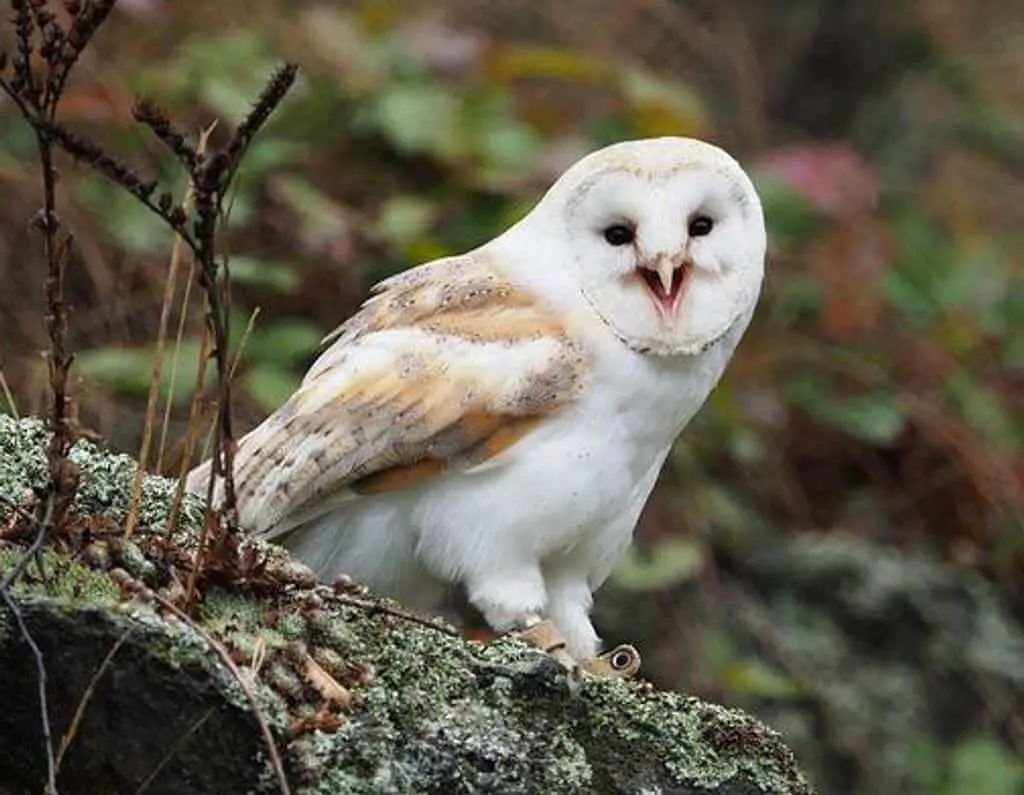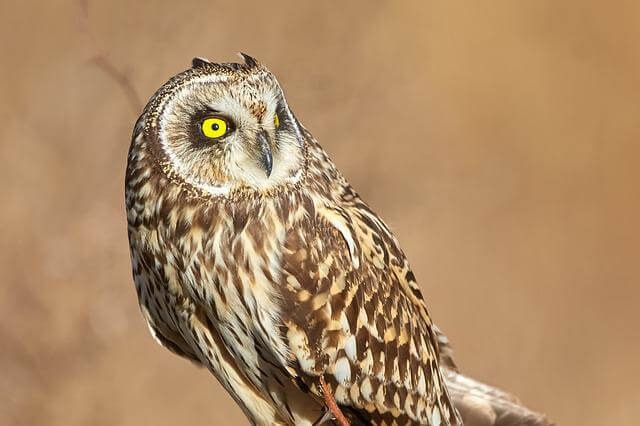Dive into the fascinating world of the 9 types of owls in Virginia! From the petite Eastern Screech-Owl to the impressive Great Horned Owl, Virginia offers a rich variety of owl species waiting to be discovered. Join us as we explore their unique features, habitats, and learn more about these captivating birds.
Table of Contents
Owls in Virginia
Barred Owl
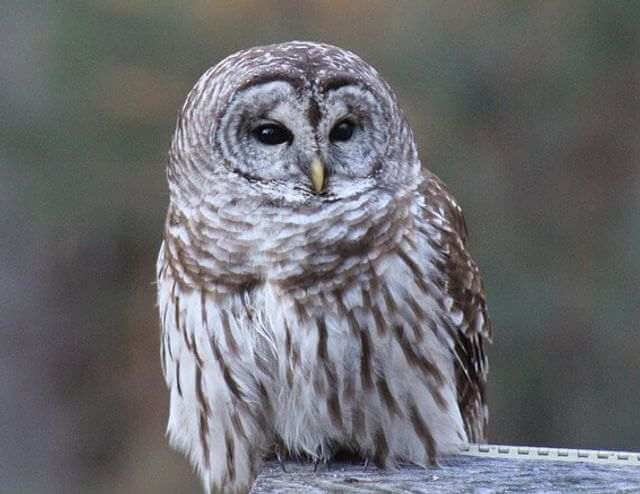
- Length: 16.9-19.7″ in (43-50 cm)
- Weight: 16.6-37.0 oz. (470-1050 g)
- Wingspan: 39.0-43.3″ in (99-110 cm)
- Scientific Name: Strix varia
- Frequency of Occurrence: 2.05% (Statistic by: eBird)
- Where To Find Them: The owl can also be seen in urban and suburban areas. Some of the most common locations where the Barred Owl can be found include Shenandoah National Park, James River Park, and Mason Neck National Wildlife Refuge.
- How to Attract: If you want to attract barred owls to your property, there are a few things you can do. First, make sure you have a large open area with plenty of trees. Barred owls like to hunt from high perches, so having plenty of trees is key. You can also create a nest box or platform for the owls to use. The box should be placed in an open area with good visibility and close to a tree for cover. Finally, make sure you provide plenty of food and water for the owls. They will eat small mammals, birds, amphibians, and insects. You can also provide them with bird feeders with owl pellets and water dishes.
General Information: The barred owl is a medium-sized raptor that ranges from 17 to 20″ inches in length and has a wingspan of about 42 inches. This owl is found in North America, where its range extends from central Canada to northern Mexico.
The barred owl prefers dense woods and swamps for habitat, although it can also be found in open areas near forests. This owl feeds mostly on small mammals such as rodents, but it will also eat birds, reptiles, and amphibians. Barred owls nest in tree cavities, laying 2-4 eggs per clutch.
Great Horned Owl

- Length: 18.1-24.8 in (46-63 cm)
- Weight: 32.1-88.2 oz. (910-2500 g)
- Wingspan: 39.8-57.1 in (101-145 cm)
- Scientific Name: Bubo virginianus
- Frequency of Occurrence: 0.8106%
- Where To Find Them: There are a few locations in Virginia where you might spot a Great Horned Owl. The first is the Blue Ridge Mountains, particularly around the George Washington and Jefferson National Forests. These birds can also be found in other mountainous areas of the state, such as the Allegheny and Shenandoah National Parks. If you’re near a body of water, keep an eye out for Great Horned Owls near marshes, swamps, and other wetland habitats. Finally, they can sometimes be seen in agricultural areas or open woodlands.
- How to Attract: This owl can be attracted to areas where they can hunt by providing an appropriate habitat and food sources. The Great Horned Owl typically nests in trees, but will also use abandoned buildings or other structures. They require a large area for hunting, so providing a mix of forested and open land is ideal. In addition, keeping a healthy population of small mammals and birds in the area will help attract this owl. Providing a water source is also important.
General Information: The great horned owl is a large, powerful owl found in North and South America. They are the most common owl in North America and can be found in a wide variety of habitats, from forests to deserts. These owls feed on a variety of prey, from small mammals to birds.
They also eat insects, reptiles, and amphibians. Great horned owls nest in trees, often using abandoned hawk or eagle nests. They lay 2-4 eggs and the chicks hatch about a month later.
Related Post: 35 Fun Facts About The Great Horned Owl (Detailed)
Eastern Screech-Owl
- Length: 6.3-9.8″ in (16-25 cm)
- Weight: 4.3-8.6 oz. (121-244 g)
- Wingspan: 18.9-24.0″ in (48-61 cm)
- Scientific Name: Megascops asio
- Frequency of Occurrence: 0.7510%
- Where To Find Them: They are most commonly seen in the eastern and southeastern parts of the state, but they can also be found in the Blue Ridge Mountains and western Virginia. Eastern screech-owls are generally nocturnal, but they may also be active during the day when there is enough food available.
- How to Attract: These owls are mostly nocturnal, but they can also be active during the day. Eastern Screech-Owls can be attracted to your backyard by providing them with a few key features. One of the most important is a source of water, such as a birdbath or pond. They also need a place to perch, such as a tree or tall shrub. You can also provide some food for these owls by putting up a bird feeder.
General Information: Eastern screech-owls are found in the eastern half of the United States, from southern Canada to northern Florida, and in eastern Mexico. They live in a variety of habitats, including forests, woodlands, swamps, and parks.
These owls eat mostly small rodents such as mice and rats, but they will also eat lizards, insects, and other small animals. Eastern screech-owls build their nests in tree cavities or on ledges. A typical clutch contains two to four eggs.
Short-eared Owl
- Length: 13.4-16.9 in (34-43 cm)
- Weight: 7.3-16.8 oz. (206-475 g)
- Wingspan: 33.5-40.5 in (85-103 cm)
- Scientific Name: Asio flammeus
- Frequency of Occurrence: 0.1043%
- Where To Find Them: In Virginia, they are most commonly seen in the western part of the state near the Allegheny and Blue Ridge Mountains. They have also been spotted in other areas around the state, including the Northern Neck and Eastern Shore.
- How to Attract: One of the best ways is to provide a safe place for them to nest. This could be done by putting up a nest box or creating a roosting area out of dense shrubs. You can also provide food for the owls by putting up feeders filled with small mammals, such as mice.
General Information: The short-eared owl (Asio flammeus) is a medium-sized owl found in open country and wetlands in North America and Eurasia. They are mostly active at night, but during the day they can be seen perched on fence posts or telephone wires.
They feed on small mammals such as rodents, but also take birds, reptiles, and insects. They breed in the spring, building a platform nest of sticks in a tree or bush. 4-7 eggs are laid and incubated by the female for about 28 days. The young owls fledge at about 5 weeks old.
Barn Owl
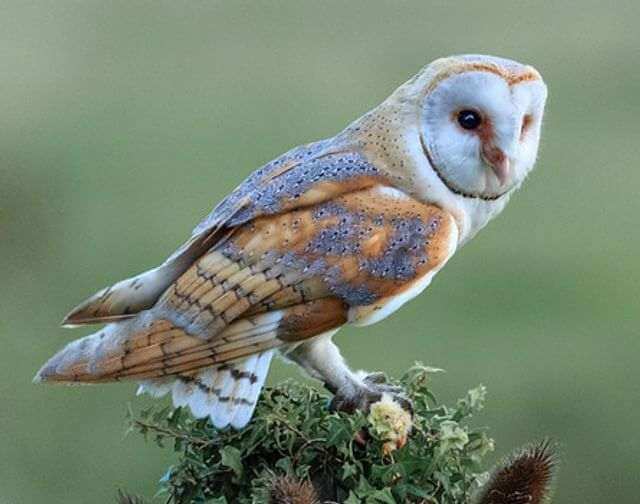
- Length: 12.6-15.8″ in (32-40 cm)
- Weight: 14.1-24.7 oz. (400-700 g)
- Wingspan: 39.4-49.2″ in (100-125 cm)
- Scientific Name: Tyto alba
- Frequency of Occurrence: 0.0949%
- Where To Find Them: They are seen in many different areas of the state, but they prefer to live in open, grassy areas near a large body of water. Some places where you can see them are at the Wildlife Center of Virginia in Waynesboro, the Natural Bridge State Park, and on the campus of James Madison University.
- How to Attract: Barn owls can be attracted to your property by erecting an owl house and providing a food supply. Owl houses should be placed in a location that is sheltered from the wind and facing south or east. The entrance hole should be 1-2 inches wide, and the house should be large enough to accommodate several nesting pairs. The floor of the house should be lined with soft material, such as hay or straw. To provide a food supply for barn owls, place a dish of fresh meat or fish near the owl house. You can also place rodent traps in an area where barn owls are likely to hunt.
General Information: The barn owl is one of the most widespread owls in the world, found on every continent except Antarctica. Barn owls inhabit a variety of habitats, including forests, grasslands, deserts, and marshes. They are also commonly found in agricultural areas and near human settlements.
The barn owl’s diet consists mainly of small mammals such as rodents, but they will also eat birds, reptiles, amphibians, fish, and insects. They typically nest in hollow trees or buildings but can also use caves or other abandoned structures.
Snowy Owl
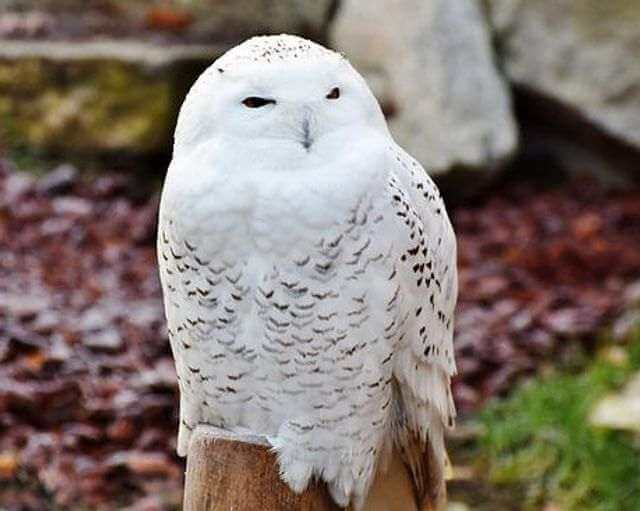
- Length: 20.5-27.9 in (52-71 cm)
- Weight: 56.4-104.1 oz. (1600-2950 g)
- Wingspan: 49.6-57.1 in (126-145 cm)
- Scientific Name: Bubo scandiacus
- Frequency of Occurrence: 0.0572%
- Where To Find Them: Snowy owls are attracted to open areas near water, where they can find prey such as small mammals and birds. Some of the best places to see a snowy owl in Virginia include the James River Park System in Richmond, Chesapeake Bay Bridge-Tunnel, and Cape Charles.
- How to Attract: Snowy owls are not easy to attract, but with some tips, you can increase your chances of seeing one. The best way to attract a snowy owl is to provide them with a food source. They mainly eat small rodents, so try to provide a space where rodents can live. If you have a barn or outbuilding on your property, this is the perfect place for a snowy owl to live. Another way to attract them is by using an owl decoy. Place the decoy in an open area where there is plenty of prey available. Make sure the decoy is realistic looking and that it is mounted on a sturdy post or platform.
General Information: Snowy owls are typically found in the northern tundra and Arctic regions of the world. They are well-adapted to living in very cold climates and prefer open areas with few trees, where they can easily spot prey. Their diet consists mostly of small rodents, but they will also eat birds, insects, and other small animals.
Snowy owls build their nests on the ground, often using a mound of hay or grass as a foundation. Females lay between 2-12 eggs and incubate them for about 28 days. Males help to care for the young once they hatch.
Related Post: 48 Fun Facts About Snowy Owls (with Photos, ID & Info)
Long-eared Owl
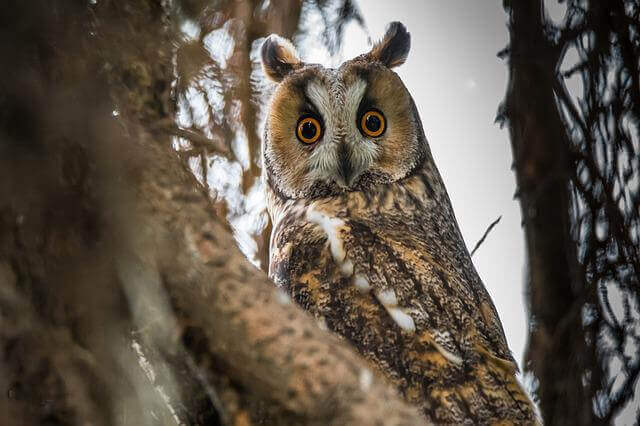
- Length: 13.8-15.8 in (35-40 cm)
- Weight: 7.8-15.3 oz. (220-435 g)
- Wingspan: 35.4-39.4 in (90-100 cm)
- Scientific Name: Asio otus
- Frequency of Occurrence: 0.0327%
- Where To Find Them: In Virginia, long-eared owls can be found in all areas of the state. They are most commonly seen in the eastern half of the state, but can also be found in the western mountains and Piedmont regions. They are typically seen near water sources, such as rivers and marshes.
- How to Attract: There are many ways to attract long-eared owls to your backyard. One way is to put up a nesting box. Long-eared owls like to nest in tall trees or in boxes that are placed high off the ground. You can also put out owl pellets, which are the regurgitated fur, bones, and other indigestible parts of their prey. This will give the owls a place to hunt and will also help you learn what they are eating. Finally, you can try to create a habitat that is similar to what they would find in the wild. This could include areas with dense shrubs and trees, as well as open fields for hunting.
General Information: The long-eared owl is a medium-sized owl that is found in North America, Europe, and Asia. The long-eared owl is unique in that it has the longest ears of any owl. The long-eared owl’s range extends from Canada to Mexico, and from the Atlantic Ocean to the Pacific Ocean.
The long-eared owl inhabits a variety of habitats, including forests, marshes, and grasslands. The diet of the long-eared owl consists of small mammals, such as mice, rats, and voles. The long-eared owl nests in tree cavities or abandoned buildings.
Northern Saw-whet Owl
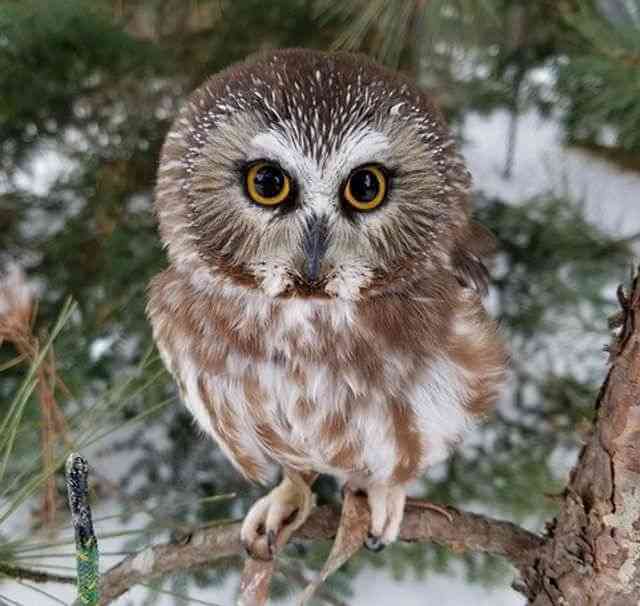
- Length: 7.1-8.3 in (18-21 cm)
- Weight: 2.3-5.3 oz. (65-151 g)
- Wingspan: 16.5-18.9 in (42-48 cm)
- Scientific Name: Aegolius acadicus
- Frequency of Occurrence: 0.0202%
- Where To Find Them: In Virginia, they are seen mostly in the higher elevations of the Blue Ridge and Appalachian Mountains.
- How to Attract: To create a hospitable environment for Northern Saw-whet Owls, you should provide a mix of dense shrubs and trees, as well as open spaces. They like to nest in dense thickets near the edge of a forest, or in a stand of trees with plenty of large branches for roosting. You can also create an owl habitat by leaving some dead trees or snags standing, as these provide good nesting sites and hunting perches.In addition to providing the right habitat, you can also help attract Northern Saw-whet Owls to your backyard by putting out food., such as owl pellets.
General Information: Northern Saw-whet Owls are the smallest owl in North America. They have a range that extends from central Canada to Central America. In the United States, they can be found in the Northeast, Midwest, and Pacific Northwest. Northern Saw-whet Owls inhabit dense forests near streams or other water sources.
They eat small rodents, such as mice and rats, as well as insects. Northern Saw-whet Owls build their nests on tree branches close to the trunk. The female lays 2-6 eggs and incubates them for about 28 days. The young owls fledge at about 7 weeks old.
Related Post: What is the Smallest Owl in North America?
Burrowing Owl
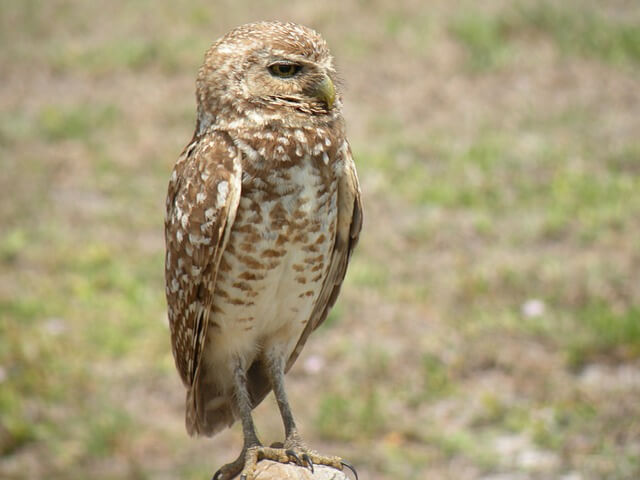
- Length: 7.5-9.8″ in (19-25 cm)
- Weight: 5.3 oz. (150 g)
- Wingspan: 21.6″ in (55 cm)
- Scientific Name: Athene cunicularia
- Frequency of Occurrence: 0.0002%
- Where To Find Them: In Virginia, the burrowing owl is most commonly seen in the Shenandoah Valley and in the Piedmont region. The bird can also be found in other parts of the state, but is less common.
- How to Attract: Burrowing Owls are usually shy and secretive birds, but they can be attracted to yards and gardens if you provide the right habitat and food. If you want to attract a Burrowing Owl to your yard or garden, you should provide a mix of open areas and dense cover. The owls need a place to hide from predators and to hunt small mammals, so make sure there are plenty of shrubs and trees nearby. You can also create a nesting site for the owls by digging a shallow hole in the ground and filling it with straw or other soft materials.
General Information: The Burrowing Owl (Athene cunicularia) is a small, common owl found in open country across North America. It is the only owl that nests in the ground, typically in abandoned animal burrows. Burrowing Owls have a large range, occurring from Alaska to southern California and east to the Great Plains. They are most common in open habitats such as grasslands, prairies, and deserts.
Burrowing Owls eat mostly small mammals such as mice, voles, and rabbits. They also eat some birds and insects. In winter, they may switch to largely eating insects. Nesting season for Burrowing Owls runs from March through July. The owls lay 2-7 eggs and both parents help incubate the eggs and care for the young chicks.
Related Article: Really Cool Burrowing Owl Facts That Will Amaze You!

